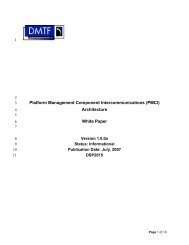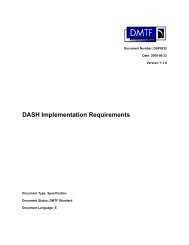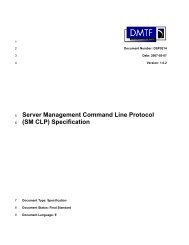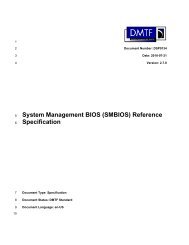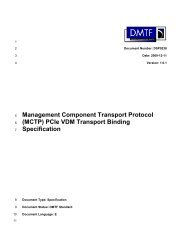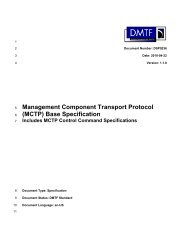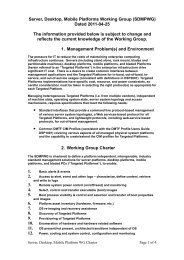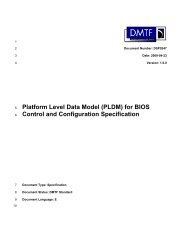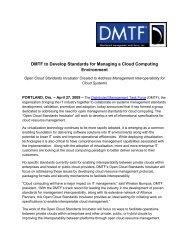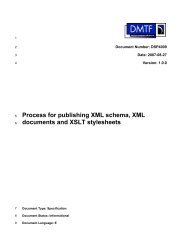ASF Specification v2.0 DSP0136 - DMTF
ASF Specification v2.0 DSP0136 - DMTF
ASF Specification v2.0 DSP0136 - DMTF
You also want an ePaper? Increase the reach of your titles
YUMPU automatically turns print PDFs into web optimized ePapers that Google loves.
Alert Standard Format (<strong>ASF</strong>) <strong>Specification</strong> <strong>v2.0</strong><br />
<strong>DMTF</strong> Document <strong>DSP0136</strong><br />
PET Variable<br />
Binding Field<br />
Trap Source<br />
Type<br />
Event Source<br />
Type<br />
Event Severity<br />
Sensor Device<br />
Sensor Number<br />
Entity<br />
Entity Instance<br />
Event Data<br />
Language Code<br />
Manufacturer<br />
ID<br />
System ID<br />
Description<br />
The Trap Source Type is the device or software that originated the trap on the network.<br />
Normally it will be the NIC (50h), the System Management Card (58h), or the Modem<br />
(60h).<br />
The Event Source Type describes the originator of the event. The Event Source Type<br />
is <strong>ASF</strong> 1.0 (68h) for all PET frames defined by this specification.<br />
Event Source Type values in the range 68h to 6Fh are reserved by [PET] for <strong>ASF</strong> use:<br />
68h<br />
<strong>ASF</strong> 1.0 Implementation<br />
69h-6Fh Reserved for future assignment by this (<strong>ASF</strong>) specification.<br />
The Event Severity setting is met to give a management station an indication of the<br />
severity of the event in the PET Frame. Typical values are Monitor (0x01), Non Critical<br />
(0x08), or Critical Condition (0x10).<br />
The Sensor Device is the SMBus address of the sensor that caused the event for the<br />
PET Frame. In the case of a poll, the address of the polled sensor is used. In the case<br />
of a push, the address of the pushing sensor is used. If there is no SMBus address<br />
associated to the event (e.g. a firmware error or firmware progress message), then the<br />
value is 0xFF (unspecified).<br />
If an SMBus address is represented in this field, bits 7 through 1 contain the address,<br />
and bit 0 is set to 0b.<br />
The Sensor Number is used to identify a given instance of a sensor relative to the<br />
Sensor Device. Values of 00h and FFh identify that the Sensor Number is not<br />
specified.<br />
The Entity indicates the platform device or subsystem associated with the event,<br />
usually identifying a Field Replaceable Unit (FRU). For example, an over-temperature<br />
event with this field set to “Processor” indicates a processor over-temperature event.<br />
When a system includes multiple device instances, e.g. a multi-processor system,<br />
Entity Instance identifies which unique device is associated with the event. For<br />
example, if a system has two processors, this field distinguishes between events<br />
associated with Processor #1 and Processor #2. A value of 00h in this field indicates<br />
that Entity Instance is unspecified.<br />
The Event Type determines the Event Data. Some of the PET messages defined in<br />
this specification allow the inclusion of a variable number of event data bytes, to further<br />
describe the event. When event data is included, the first byte of event data (Event<br />
Data 1) defines the format of Event Data bytes 2 through 5 that follow, using the<br />
following enumerations:<br />
00b Data not specified<br />
01b Data conforms to standard definitions<br />
10b Data conforms to OEM definitions<br />
11b Reserved for future assignment<br />
ED1 Bit Range Description<br />
7:6 Defines the format of Event Data 2<br />
5:4 Defines the format of Event Data 3<br />
3:2 Defines the format of Event Data 4<br />
1:0 Defines the format of Event Data 5<br />
Note: Values in Event Data bytes 6 through 8 are OEM-specific and outside the range<br />
of this specification.<br />
The Language Code is used with the OEM Custom Fields. For PET frames that do not<br />
have any OEM specific data, the language code should be set to FFh (unspecified).<br />
The IANA Manufacturer ID associated with the alerting system. The value is specified<br />
by the system’s ACPI implementation, see 4.1.2.1 <strong>ASF</strong>_INFO on page 50 for details.<br />
The manufacturer associated with the alerting system assigns the system identifier.<br />
The value is specified by the system’s ACPI implementation, see 4.1.2.1 <strong>ASF</strong>_INFO on<br />
page 50 for details.<br />
<strong>DSP0136</strong> 23 April 2003 Page 9 of 94



